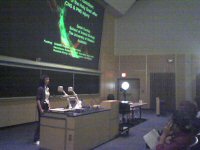Main Menu
Welcome
 Interestingly enough and I don't know yet if I like that, a medical researcher gave the second plenary lecture of this day. Sarah Dunlop from the University of Western Australia works on brain trauma. I don't know yet what this has to do with neuroethology, but maybe the talk will enlighten me.
Interestingly enough and I don't know yet if I like that, a medical researcher gave the second plenary lecture of this day. Sarah Dunlop from the University of Western Australia works on brain trauma. I don't know yet what this has to do with neuroethology, but maybe the talk will enlighten me.Apparently, Sarah studies a number of different animal species for their development and repair mechanisms. What she is testing is regeneration of the optic system after lesions to the optical nerve. She found that fish and amphibians seem to regenerate fine, birds and mammals don't and reptiles do morphologically regenerate but remain blind due to non-functional regeneration. The reason for the failed reptilian regeneration apparently is the failure to re-construct an accurate topographic map in the optic tectum. She went on to highlight some of the molecular differences between the species underlying the regeneration differences. For instance, blocking certain developmental gene products or neurotransmitters in the fully regenerating fish leads to the partially regenerating phenotype of reptiles. The mechanism appears to work via different synaptic properties of fish and reptile neurons. With this knowledge, they should be able to do the reverse, namely turn a partially regenerating reptile into a fully regenerating fish. However, here the talk didn't go on to show how to manipulate these mechanisms in lizards to make regenerate fully like fish. Instead, she started to talk about using behavioral training to enhance regeneration by restoring the topographic maps. Weird.
Anyway, the remainder of the talk was about peripheral nervous system regeneration. The first model here was facial nerve damage in rats. This damage in rats normally leads to dysfunctional regeneration (lost whisker movements). Whisker training (stimulating whiskers by stroking with the hand) does restore some of the function. Interestingly, active whisking was restored without restoring topography in the nervous system. The second model involved crushing the hypoglossal nerve, leading to loss of tongue function. Here training (licking) worked, but wasn't as effective as in the facial nerve. Thirdly, she looked at the median nerve containing both sensory and motor components (while the first two models were motor nerves only). There, training was least effective.
The final,minutes of the talk was about the "Move Again Program" (MAP) trying to apply her training results to patients with brain or nerve trauma.
In total: she's a great speaker, the talk was very informative, interesting, lively and entertaining. I really had great fun, learned a lot and greatly enjoyed the talk. Moreover, I have no doubt that her research is not only of very high quality, but also will make a tremendous difference to people suffering from brain or nerve injury. That said, I don't think that the topic really had all that much to do with neuroethology. I'm skeptical if trying to appeal to the medical community really is a good approach to make neuroethology more interesting for medical funding agencies (if this was the intention of the organizers inviting her at all). Whatever the motives, I feel the talk was too off-topic and did not represent neuroethology enough to justify this invitation, no matter the quality or apparent medical relevance of it. Neuroethology is not a medical research topic, it's a science. Medicine is not a science, strictly speaking.

Posted on Wednesday 25 July 2007 - 19:04:43 comment: 0
{TAGS}
{TAGS}
Render time: 0.0800 sec, 0.0040 of that for queries.





